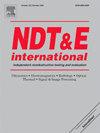Depth estimation of internal defects from a sensitive frequency using thermal wave radar
IF 4.1
2区 材料科学
Q1 MATERIALS SCIENCE, CHARACTERIZATION & TESTING
引用次数: 0
Abstract
Thermal wave radar is one of the active infrared thermographic techniques that detects defects by applying a broadband frequency modulated excitation and cross-correlation. Although it outperforms conventional methods in the depth resolvability and defect detectability, there still exist difficulties in the estimation of defect depth due to the distortion effect of heat diffusion and noises. This work aims to estimate the depth of an internal defect using a new parameter instead of the widely used blind frequency, namely the sensitive frequency, at which a maximum phase contrast is reached. The thermal wave radar is implemented by using a linear frequency modulated laser excitation. The phase contrast in function of frequency is obtained from the dual orthogonal demodulation algorithm. A linear relationship with calibrated coefficients is established between the sensitive frequency and the reciprocal of the square of depth. The effect of defect size on the linear relationship is studied, and a correction of the linear relationship is proposed to improve the accuracy of depth estimation. The proposed method is numerically verified and experimentally validated, and the results illustrated that the depths of defects with various aspect ratios can be well estimated.
利用热波雷达从敏感频率估计内部缺陷的深度
热波雷达是一种主动红外热成像技术,利用宽带调频激励和互相关技术来检测缺陷。尽管该方法在深度可分辨性和缺陷可检测性方面优于传统方法,但由于热扩散和噪声的畸变影响,缺陷深度估计仍然存在困难。这项工作的目的是使用一个新的参数来估计内部缺陷的深度,而不是广泛使用的盲频率,即敏感频率,在该频率处达到最大相位差。热波雷达采用线性调频激光激励实现。利用对偶正交解调算法,得到了频率函数的相位差。在标定系数下,敏感频率与深度平方倒数之间建立了线性关系。研究了缺陷尺寸对线性关系的影响,提出了一种修正线性关系的方法,以提高深度估计的精度。通过数值和实验验证了该方法的有效性,结果表明该方法能较好地估计出不同纵横比缺陷的深度。
本文章由计算机程序翻译,如有差异,请以英文原文为准。
求助全文
约1分钟内获得全文
求助全文
来源期刊

Ndt & E International
工程技术-材料科学:表征与测试
CiteScore
7.20
自引率
9.50%
发文量
121
审稿时长
55 days
期刊介绍:
NDT&E international publishes peer-reviewed results of original research and development in all categories of the fields of nondestructive testing and evaluation including ultrasonics, electromagnetics, radiography, optical and thermal methods. In addition to traditional NDE topics, the emerging technology area of inspection of civil structures and materials is also emphasized. The journal publishes original papers on research and development of new inspection techniques and methods, as well as on novel and innovative applications of established methods. Papers on NDE sensors and their applications both for inspection and process control, as well as papers describing novel NDE systems for structural health monitoring and their performance in industrial settings are also considered. Other regular features include international news, new equipment and a calendar of forthcoming worldwide meetings. This journal is listed in Current Contents.
 求助内容:
求助内容: 应助结果提醒方式:
应助结果提醒方式:


